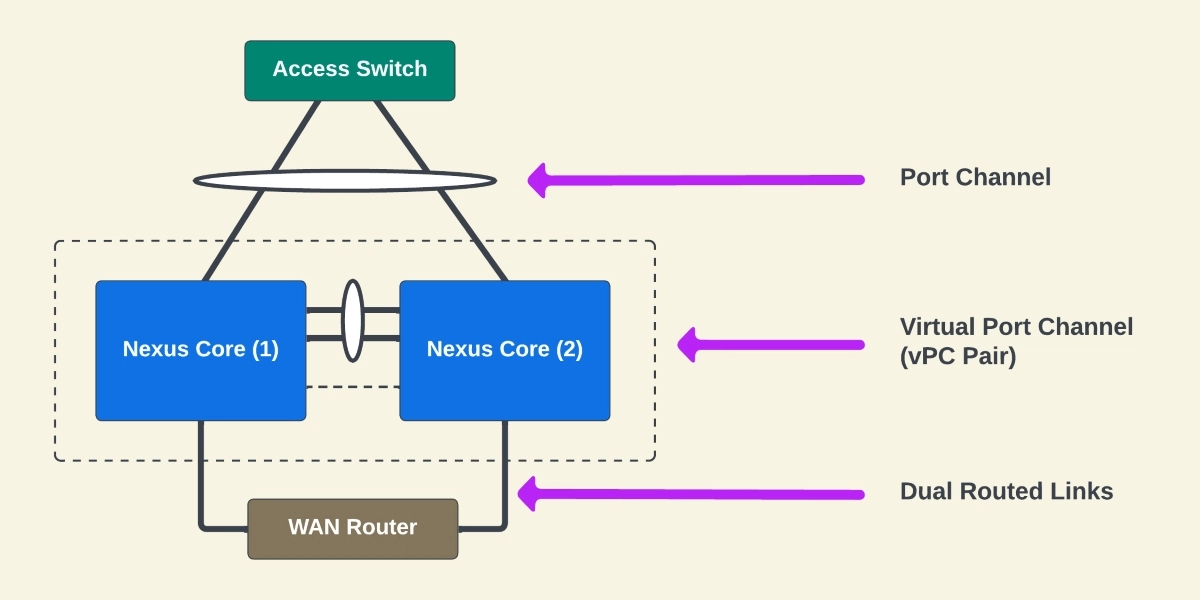The path cost is the metric Spanning Tree (STP) uses to calculate the shortest path to the elected root bridge. The slower the interface, the higher the cost is. The path with the lowest cost will be used to reach the root bridge.
In this post, you’re going to learn about the short and long STP Path Cost Methods, and how they differ.
Advertisement
Short vs Long
The path cost is based on the speed of the switch’s port or interface. When Spanning Tree was developed, a field of 16 bits was assigned to the Spanning Tree path cost, which is also known as the short method. The following table shows the default cost values assigned to interfaces using the short method.
| Port Speed | Default Cost Value |
|---|---|
| 10 Mbps | 100 |
| 100 Mbps | 19 |
| 1 Gbps | 4 |
| 10 Gbps | 2 |
| 25 Gbps | 1 |
| 40 Gbps | 1 |
| 100 Gbps | 1 |
NOTE: These STP costs can be manually configured on every interface. See below how you can change interface G0/0, a 1 Gbps port with a default STP cost of 4, to an STP cost of 10.
Switch#show interface gi0/0 | i BW MTU 1500 bytes, BW 1000000 Kbit/sec, DLY 10 usec, Switch# Switch#show spanning-tree interface gi0/0 Vlan Role Sts Cost Prio.Nbr Type ------------------- ---- --- --------- -------- -------------------------------- VLAN0001 Root FWD 4 128.1 P2p Switch# Switch#config term Enter configuration commands, one per line. End with CNTL/Z. Switch(config)#interface gi0/0 Switch(config-if)#spanning-tree cost 10 Switch(config-if)#end Switch# *Feb 16 20:33:40.824: %SYS-5-CONFIG_I: Configured from console by console Switch#show spanning-tree interface gi0/0 Vlan Role Sts Cost Prio.Nbr Type ------------------- ---- --- --------- -------- -------------------------------- VLAN0001 Altn BLK 10 128.1 P2p Switch#
As interface bandwidths increased, the 16-bit value did not provide room for newer high-speed interfaces. In the table above, notice that Spanning Tree assigns a cost of 1 to 25, 40, and 100 Gbps Ethernet interfaces and therefore cannot judge what link is better over the other to reach the root bridge. STP treats all three links the same and as a result, Spanning Tree may not prefer a 100 Gbps over a 25 Gbps interface based on the local STP cost of the interfaces. This limitation can be overcome with the Spanning Tree long method.
The newer Spanning Tree long mode path cost method increased the port cost field from 16 to 32 bits. The short method uses a 16-bit format that yields values from 1-65535 whereas the long method uses a 32-bit format that yields values from 1-200,000,000, which provides more granularity in data centers that use extremely high-speed interfaces.
The Cisco command to enable the long method is spanning-tree path cost method long. This command increases the path cost field from 16 to 32 bits.
| Port Speed | Default Cost Value |
|---|---|
| 100 Kbps | 200000000 |
| 1 Mbps | 20000000 |
| 10 Mbps | 2000000 |
| 100 Gbps | 200000 |
| 1 Gbps | 20000 |
| 10 Gbps | 2000 |
| 25 Gbps | 800 |
| 40 Gbps | 500 |
| 100 Gbps | 200 |
| 1 Tbps | 20 |
| 10 Tbps | 2 |
But, how do you calculate the STP Port Cost? Let’s take a look.
Advertisement
How to Manually Calculate the STP Path Cost Long Method?
The maximum value is 20,000,000,000, so to calculate the STP cost value in long mode, you divide this value by the port speed in Kbps. See the table below.
| Port Speed | STP Cost Calculation |
|---|---|
| 100 Kbps | 20,000,000,000 / 100 Kbps = 200,000,000 |
| 1 Mbps | 20,000,000,000 / 1,000 Kbps = 20,000,000 |
| 10 Mbps | 20,000,000,000 / 10,000 Kbps = 2,000,000 |
| 100 Mbps | 20,000,000,000 / 100,000 Kbps = 200,000 |
| 1 Gbps | 20,000,000,000 / 1,000,000 Kbps = 20,000 |
| 10 Gbps | 20,000,000,000 / 10,000,000 Kbps = 2,000 |
| 25 Gbps | 20,000,000,000 / 25,000,000 Kbps = 800 |
| 40 Gbps | 20,000,000,000 / 40,000,000 Kbps = 500 |
| 100 Gbps | 20,000,000,000 / 100,000,000 Kbps = 200 |
| 1 Tbps | 20,000,000,000 / 1,000,000,000 Kbps = 20 |
| 10 Tbps | 20,000,000,000 / 10,000,000,000 Kbps = 2 |
Advertisement
How to Enable the STP Path Cost Long Method?
Here’s how to enable STP Path Cost Long on a Cisco Catalyst switch.
Cat9500-SW01#config term Cat9500-SW01(config)#spanning-tree pathcost method long Cat9500-SW01(config)#end Cat9500-SW01#show spanning-tree summary Switch is in rapid-pvst mode Root bridge for: VLAN0001, VLAN0003, VLAN0016 Extended system ID is enabled Portfast Default is disabled Portfast Edge BPDU Guard Default is disabled Portfast Edge BPDU Filter Default is disabled Loopguard Default is disabled PVST Simulation Default is enabled but inactive in rapid-pvst mode Bridge Assurance is enabled EtherChannel misconfig guard is enabled UplinkFast is disabled BackboneFast is disabled Configured Pathcost method used is long Name Blocking Listening Learning Forwarding STP Active ---------------------- -------- --------- -------- ---------- ---------- VLAN0001 1 0 0 0 1 VLAN0003 1 0 0 0 1 VLAN0016 1 0 0 0 1 VLAN0040 0 0 0 1 1 VLAN0041 0 0 0 1 1 VLAN0042 0 0 0 1 1 VLAN0043 0 0 0 1 1 VLAN0044 0 0 0 1 1 VLAN3967 0 0 0 1 1 ---------------------- -------- --------- -------- ---------- ---------- 9 vlans 3 0 0 6 9 Cat9500-SW01#
Here’s how to enable the STP Patch Cost Long on a Nexus switch.
NX93180-Core(config)# show spanning-tree summary Switch is in rapid-pvst mode Root bridge for: VLAN0001, VLAN0016, VLAN0040-VLAN0044, VLAN3967 L2 Gateway STP is disabled Port Type Default is disable Edge Port [PortFast] BPDU Guard Default is disabled Edge Port [PortFast] BPDU Filter Default is disabled Bridge Assurance is enabled Loopguard Default is disabled Pathcost method used is short vPC peer-switch is enabled (operational) STP-Lite is disabled Name Blocking Listening Learning Forwarding STP Active ---------------------- -------- --------- -------- ---------- ---------- VLAN0001 0 0 0 2 2 VLAN0016 0 0 0 2 2 VLAN0040 0 0 0 2 2 VLAN0041 0 0 0 2 2 VLAN0042 0 0 0 2 2 VLAN0043 0 0 0 2 2 VLAN0044 0 0 0 2 2 VLAN3967 0 0 0 2 2 ---------------------- -------- --------- -------- ---------- ---------- 8 vlans 0 0 0 16 16 NX93180-Core(config)# NX93180-Core(config)# spanning-tree pathcost method long NX93180-Core(config)# show spanning-tree summary Switch is in rapid-pvst mode Root bridge for: VLAN0001, VLAN0016, VLAN0040-VLAN0044, VLAN3967 L2 Gateway STP is disabled Port Type Default is disable Edge Port [PortFast] BPDU Guard Default is disabled Edge Port [PortFast] BPDU Filter Default is disabled Bridge Assurance is enabled Loopguard Default is disabled Pathcost method used is long vPC peer-switch is enabled (operational) STP-Lite is disabled Name Blocking Listening Learning Forwarding STP Active ---------------------- -------- --------- -------- ---------- ---------- VLAN0001 0 0 0 2 2 VLAN0016 0 0 0 2 2 VLAN0040 0 0 0 2 2 VLAN0041 0 0 0 2 2 VLAN0042 0 0 0 2 2 VLAN0043 0 0 0 2 2 VLAN0044 0 0 0 2 2 VLAN3967 0 0 0 2 2 ---------------------- -------- --------- -------- ---------- ---------- 8 vlans 0 0 0 16 16 NX93180-Core(config)#
Advertisement
Thoughts on Network Design
With today’s high speed Ethernet interfaces, it is a good practice to set STP Path Cost method to long; however, you have to remember to switch the mode from short to long on all the switches in your network.
It is unlikely that modern data center designs rely on Spanning Tree for redundancy. Today’s data centers implement dual connections to their redundant network core with port channels and routed interfaces.

Although possible, it is unlikely to see switches with 100 Gbps and 40 Gbps as possible paths to the root switch and relying on Spanning Tree for Ethernet loop prevention.
